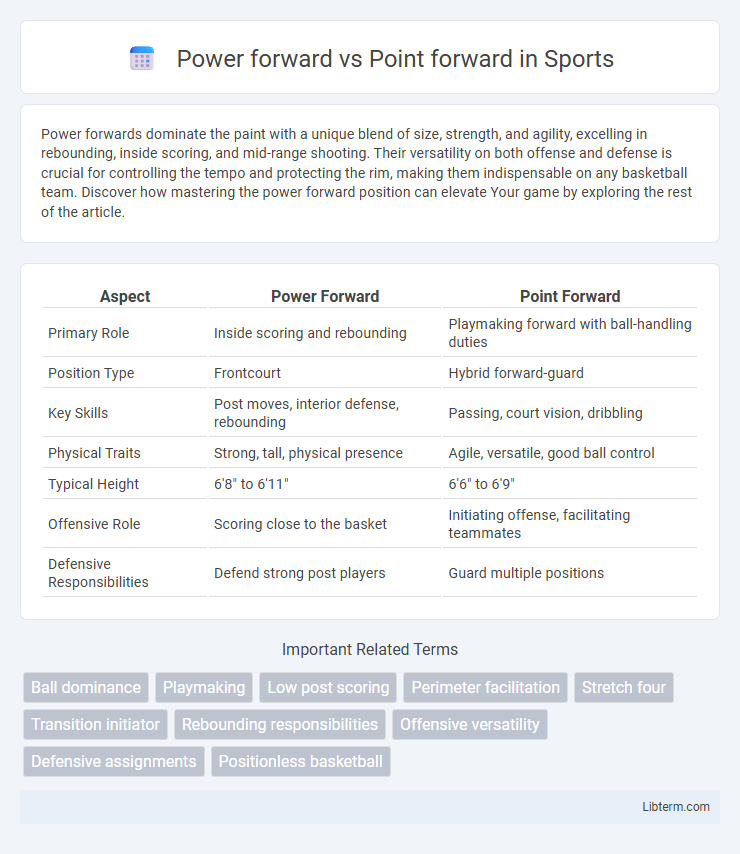Power forwards dominate the paint with a unique blend of size, strength, and agility, excelling in rebounding, inside scoring, and mid-range shooting. Their versatility on both offense and defense is crucial for controlling the tempo and protecting the rim, making them indispensable on any basketball team. Discover how mastering the power forward position can elevate Your game by exploring the rest of the article.
Table of Comparison
| Aspect | Power Forward | Point Forward |
|---|---|---|
| Primary Role | Inside scoring and rebounding | Playmaking forward with ball-handling duties |
| Position Type | Frontcourt | Hybrid forward-guard |
| Key Skills | Post moves, interior defense, rebounding | Passing, court vision, dribbling |
| Physical Traits | Strong, tall, physical presence | Agile, versatile, good ball control |
| Typical Height | 6'8" to 6'11" | 6'6" to 6'9" |
| Offensive Role | Scoring close to the basket | Initiating offense, facilitating teammates |
| Defensive Responsibilities | Defend strong post players | Guard multiple positions |
Introduction to Power Forward and Point Forward Roles
The power forward in basketball typically plays near the basket, specializing in rebounding, inside scoring, and physical defense, often acting as a team's secondary post presence. The point forward combines the skill set of a forward with the ball-handling and playmaking duties of a point guard, facilitating offense and creating scoring opportunities for teammates. Understanding these roles highlights the strategic diversity they bring to modern basketball offenses and defenses.
Key Responsibilities of Power Forwards
Power forwards primarily focus on rebounding, interior scoring, and defending the post, utilizing their physical strength and size to control the paint area. They are responsible for setting screens, executing pick-and-roll plays, and securing second-chance points through offensive rebounds. Defensively, power forwards guard opposing big men and help protect the rim, contributing significantly to team toughness and interior presence.
Defining the Point Forward Position
The Point Forward position blends the traditional roles of a small forward and a point guard, emphasizing playmaking and ball-handling skills within a forward's size and versatility. This role requires the player to initiate the offense, distribute the ball effectively, and create scoring opportunities while also contributing defensively. Unlike the Power Forward, who primarily focuses on rebounding, interior scoring, and physical defense, the Point Forward acts as a hybrid facilitator, bridging perimeter playmaking with forward responsibilities.
Physical Attributes: Power Forward vs Point Forward
Power forwards typically exhibit greater physical strength and size, enabling them to dominate in the post and secure rebounds effectively. Point forwards possess more agility and ball-handling skills, allowing them to facilitate offense and create plays despite often being slightly smaller in stature. The contrasting physical attributes highlight the power forward's role in physicality and scoring inside, whereas the point forward blends versatility with perimeter skills.
Playmaking Skills Comparison
Power forwards typically excel in physicality and inside scoring but may offer limited ball-handling and court vision. Point forwards possess advanced playmaking skills, combining size with the ability to facilitate offense, set up teammates, and create scoring opportunities. This role shift allows point forwards to act as primary playmakers, enhancing team dynamics with their passing accuracy and basketball IQ.
Impact on Team Offense
Power forwards primarily focus on scoring in the paint, rebounding, and setting screens, which establishes a strong inside presence essential for team offense. Point forwards bring ball-handling and playmaking skills to the forward position, enabling better floor spacing and increased passing options that diversify offensive strategies. Teams utilizing point forwards often experience enhanced offensive fluidity and unpredictability, creating mismatches and improved scoring opportunities.
Defensive Duties and Versatility
Power forwards primarily focus on protecting the paint through rim guarding, rebounding, and interior defense, excelling in post defense and shot blocking. Point forwards have versatile defensive responsibilities, often tasked with guarding multiple positions, including quicker perimeter players, due to their role as playmakers and ball handlers. The point forward's adaptability enhances team defense by allowing seamless switches and coverage across various defensive assignments.
Famous Power Forwards in NBA History
Famous power forwards in NBA history like Tim Duncan, Karl Malone, and Dirk Nowitzki redefined the position with their scoring, rebounding, and defensive prowess. Unlike point forwards who handle playmaking duties, these power forwards dominated the paint and mid-range while anchoring both offense and defense. Their legacy includes multiple MVP awards, All-NBA selections, and Hall of Fame inductions, highlighting their impact on the evolution of basketball.
Iconic Point Forwards and Their Influence
Iconic point forwards like Scottie Pippen and LeBron James revolutionized their roles by blending traditional power forward physicality with point guard playmaking skills, significantly influencing modern basketball strategies. Their ability to handle the ball, make plays, and defend multiple positions demonstrated the evolving versatility demanded in the NBA. This hybrid role has shaped team dynamics and inspired a new generation of forwards emphasizing agility, court vision, and scoring.
Choosing the Right Forward for Your Team
Selecting the right forward depends on your team's strategic needs, where a power forward offers physicality and rebounding prowess, anchoring the inside game. A point forward brings versatility and playmaking ability, often initiating offense and creating scoring opportunities with ball-handling skills. Evaluating your team's roster gaps and play style determines whether the presence of size and strength or agility and court vision best enhances your competitive edge.
Power forward Infographic

 libterm.com
libterm.com